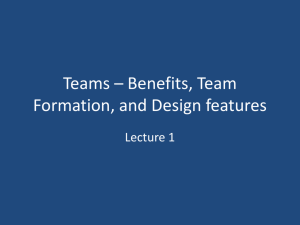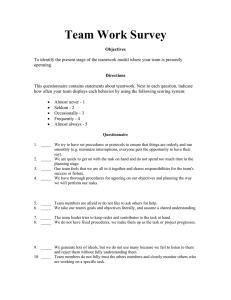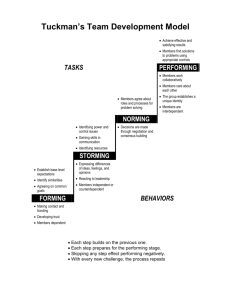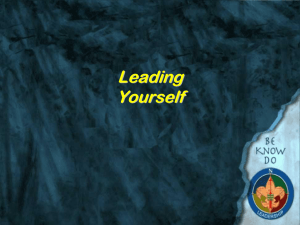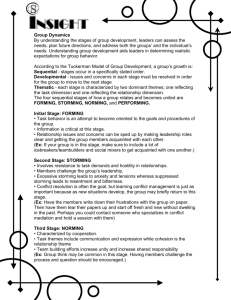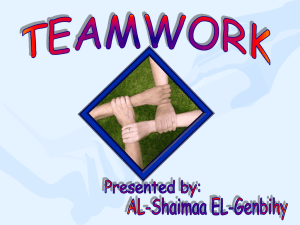Stage of team development – the Tuckman Model
advertisement
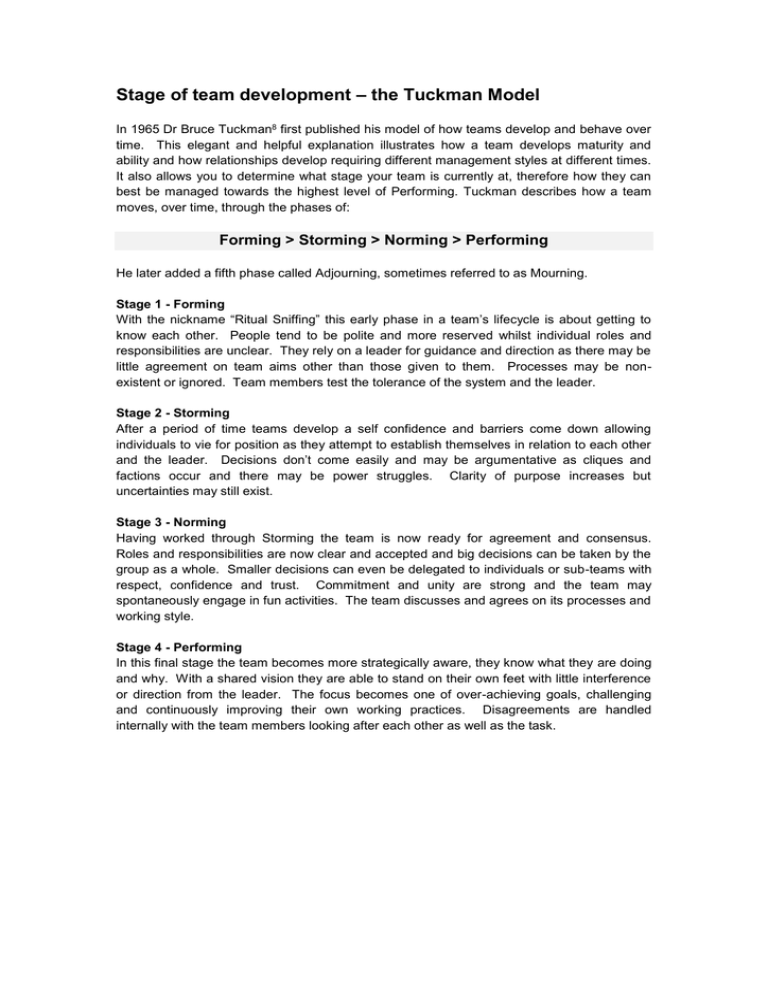
Stage of team development – the Tuckman Model In 1965 Dr Bruce Tuckman8 first published his model of how teams develop and behave over time. This elegant and helpful explanation illustrates how a team develops maturity and ability and how relationships develop requiring different management styles at different times. It also allows you to determine what stage your team is currently at, therefore how they can best be managed towards the highest level of Performing. Tuckman describes how a team moves, over time, through the phases of: Forming > Storming > Norming > Performing He later added a fifth phase called Adjourning, sometimes referred to as Mourning. Stage 1 - Forming With the nickname “Ritual Sniffing” this early phase in a team’s lifecycle is about getting to know each other. People tend to be polite and more reserved whilst individual roles and responsibilities are unclear. They rely on a leader for guidance and direction as there may be little agreement on team aims other than those given to them. Processes may be nonexistent or ignored. Team members test the tolerance of the system and the leader. Stage 2 - Storming After a period of time teams develop a self confidence and barriers come down allowing individuals to vie for position as they attempt to establish themselves in relation to each other and the leader. Decisions don’t come easily and may be argumentative as cliques and factions occur and there may be power struggles. Clarity of purpose increases but uncertainties may still exist. Stage 3 - Norming Having worked through Storming the team is now ready for agreement and consensus. Roles and responsibilities are now clear and accepted and big decisions can be taken by the group as a whole. Smaller decisions can even be delegated to individuals or sub-teams with respect, confidence and trust. Commitment and unity are strong and the team may spontaneously engage in fun activities. The team discusses and agrees on its processes and working style. Stage 4 - Performing In this final stage the team becomes more strategically aware, they know what they are doing and why. With a shared vision they are able to stand on their own feet with little interference or direction from the leader. The focus becomes one of over-achieving goals, challenging and continuously improving their own working practices. Disagreements are handled internally with the team members looking after each other as well as the task. Teamwork Questionnaire – What Stage Is Your Team In? Directions - This questionnaire contains statements about teamwork. Next to each question indicate how rarely or often your team displays each behaviour by using the following scoring system: Almost never - 1 Seldom - 2 Occasionally - 3 Frequently - 4 Almost always – 5 1. We try to have set procedures or protocols to ensure that things are orderly and run smoothly (i.e. minimise interruptions; everyone gets the opportunity to have their say). 2. We are quick to get on with the task in hand and do not spend too much time in the planning stage. 3. Our team feels that we are all in it together and shares responsibility for the team's success or failure. 4. We have thorough procedures for agreeing on our objectives and planning the way we will perform our tasks. 5. Team members are afraid to ask others for help. 6. We take our team's goals and objectives literally, and assume a shared understanding. 7. The team leader tries to keep order and contributes to the task at hand. 8. We do not have fixed procedures; we make them up as the task or project progresses. 9. We generate lots of ideas, but we do not use many because we fail to listen to them and reject them without fully understanding them. 10. Team members do not fully trust the others members and closely monitor others who are working on a specific task. 11. The team leader ensures that we follow the procedures, do not argue, do not interrupt, and keep to the point. 12. We enjoy working together; we have a fun and productive time. 13. We have accepted each other as members of the team. 14. The team leader is democratic and collaborative. 15. We are trying to define the goal and what tasks need to be accomplished. 16. Many of the team members have their own ideas about the process and personal agendas are rampant. 17. We fully accept each other's strengths and weaknesses. 18. We assign specific roles to team members (team leader, facilitator, time keeper, note taker, etc.). 19. We try to achieve harmony by avoiding conflict. 20. The tasks are very different from what we imagined and seem very difficult to accomplish. 21. There are many abstract discussions of the concepts and issues, some members are impatient with these discussions. 22. We are able to work through group problems. 23. We argue a lot even though we agree on the real issues. 24. The team is often tempted to go above the original scope of the project. 25. We express criticism of others constructively. 26. There is a close attachment to the team. 27. It seems as if little is being accomplished with the project's goals. 28. The goals we have established seem unrealistic. 29. Although we are not fully sure of the project's goals and issues, we are excited and proud to be on the team. 30. We often share personal problems with each other. 31. There is a lot of resisting of the tasks on hand and quality improvement approaches. 32. We get a lot of work done. Teamwork Questionnaire – Results Mark the score of each item on the questionnaire. When you have entered all the scores for each question, total each of the four columns. Item Score Item Score Item Score Item Score 1. _______ 2. _______ 4. _______ 3. _______ 5. _______ 7. _______ 6. _______ 8. _______ 10. _______ 9. _______ 11. _______ 12. _______ 15. _______ 16. _______ 13. _______ 14. _______ 18. _______ 20. _______ 19. _______ 17. _______ 21. _______ 23. _______ 24. _______ 22. _______ 27. _______ 28. _______ 25. _______ 26. _______ 29. _______ 31. _______ 30. _______ 32. _______ TOTAL _____ TOTAL _____ TOTAL _____ TOTAL _____ Forming Stage Storming Stage Norming Stage Performing Stage This questionnaire is to help you assess what stage your team normally operates. The highest of the four scores indicates which stage you perceive your team to operate in. If your highest score is 32 or more, it is a strong indicator of the stage your team is in. The lowest of the three scores is an indicator of the stage your team is least like. If your lowest score is 16 or less, it is a strong indicator that your team does not operate this way. If two of the scores are close you are probably going through a transition phase, except: If you score high in both the Forming and Storming Phases, then you are in the Storming Phase If you score high in both the Norming and Performing Phases, then you are in the Performing Stage. Your role at each stage Regardless as to your role in the team the most valuable part you can play is to recognise at which stage the team is at and then provide the appropriate leadership or management. Helping a Forming Team The manager, team leader, consultant provides clear direction, telling people what is expected of them and how they need to do it. The leader must be prepared to answer lots of questions about the team’s purpose, objectives and external relationships. Patience is required as people work through their confusion or misunderstanding. Communication is vital as is structured time dedicated to getting to know each other. This will accelerate the team into the Storming phase. Helping a Storming Team The leader needs to focus the team on its goals and processes to avoid it becoming distracted by relationships and emotional issues. Compromises and consensus may be required to enable progress as does a skill in handling conflict constructively and assertively. The leader moves into more of a coaching role which is less likely to create antagonism and starts to develop a self reliance within the team. This will accelerate the team into the Norming phase. Helping a Norming Team Facilitation is the style for managing a Norming team with respect being shown by the leader and the members. By facilitating and enabling the manager allows the group to take on more responsibility and make their own decisions, stepping in only rarely if the situation absolutely requires it. The leader wants to ensure that the Purpose remains clear so that they can challenge the team, should they become complacent, so as to accelerate them into the Performing phase. Helping a Performing Team A leader delegates and oversees a performing team, resisting the urge to instruct or assist when not required. They continue to be invaluable as a source of advice for personal and interpersonal development as well as for reward and recognition. Also they need to keep close to the team because as personnel or organisational change inevitably occurs the team will start Mourning before the cycle starts again.
